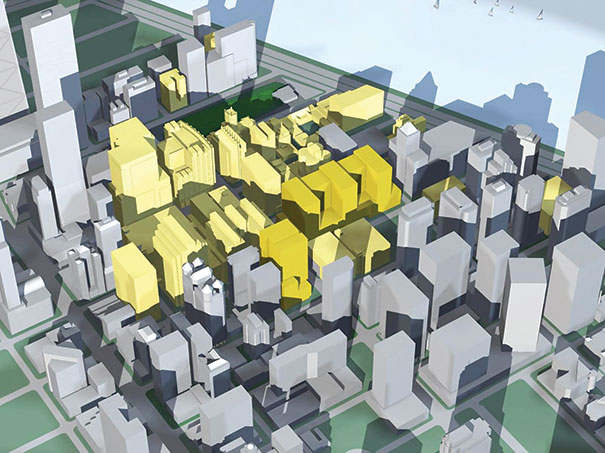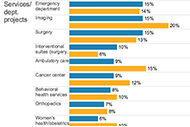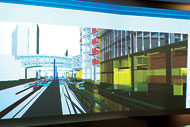 |
|
IMAGE COURTESY OF CANNONDESIGN A BIM-generated model of Northwestern Medicine’s downtown Chicago campus. |
When Northwestern Medicine (NM) mandated the use of building information modeling (BIM) in 2011 for all projects going forward, facility managers likely breathed a sigh of relief.
The first project under the mandate was an outpatient care pavilion, a 1-million-square-foot, 25-story building on NM’s downtown Chicago campus.
Facility managers giving regular input on the BIM digital model offering the physical and functional characteristics of the building not only were able to help designers prevent infrastructure clashes early on, but continue to rely on BIM to access operational and maintenance documents at the facility since its opening this year.
“We relied heavily on feedback from facilities managers during the construction process,” says Shrimant Jaruhar, BIM manager, department of facility planning and construction, at NM. “They have been very willing partners who are generally excited about what BIM is helping them to accomplish through consolidated access to all building data. This has a direct impact on reducing time taken to address work orders in addition to more effective preventive maintenance.”
While Northwestern is among the first to mandate BIM technology, others likely will follow, experts say. In addition, facility managers will begin focusing on BIM’s largely untapped potential as a post-construction tool through the life of the building.
BIM is just one example of the new and evolving technologies being widely embraced by facilities, design and environmental services (ES) leaders who are striving to do their jobs better, faster, within budget and under the mandates of the Affordable Care Act.
Everything from software that measures energy consumption to smartphones and tablets that help facility managers to track equipment remotely is becoming part of the daily routines of future-focused managers’ seeking maximum efficiency for their money. Along with tapping the potential of existing technology, it’s critical that managers stay on top of new advancements as well, says Leo Gehring, CHFM, CHC, FASHE, principal of Gehring Health Facilities Resources.
“All facility managers are focused on benchmarking and outcomes, which hinges completely on technology,” says Gehring. “Those who don’t want to use technology to its full potential do so at their own peril.”
The BIM explosion
While some technologies are just getting out of the gate, others — like BIM — are exploding.
“I’m not surprised at how quickly BIM has taken hold because of its enormous value,” says Joseph G. Sprague, FAIA, FACHA, FHFI, principal and senior vice president at HKS Inc., Dallas. “It expedites construction; facilitates communication between designers, facility managers and contractors; reduces redundancies; tracks building information — just tremendous advantages.”
By creating a digital database that represents the building in 3-D, BIM allows the design team, building owners, facility managers and contractors to virtually “walk” through a structure before it’s built. Its capability for averting design “clashes” is especially valuable for saving time, money and headaches down the road.
For example, NM facilities managers who met biweekly with designers during the design phase relocated a boiler that looked fine on floor plans but was deemed inaccessible by facilities managers who viewed the 3-D model.
Used to enhance computerized maintenance management systems (CMMS), BIM includes essential data on asset names, model numbers and warranty information and can include hyperlinks to information on equipment and maintenance procedures. Facility managers can access this information with a single click on any computer or tablet — a feature many are just beginning to tap into.
“Other organizations have adopted BIM technology, but they haven’t taken it beyond the end of the project. The data in the model need to be structured to meet the needs of facility operators, and that structure is something health care organizations need to really think about,” says Jaruhar. “Using it post-construction is the next step.”
This untapped potential is one frustrating example of the tremendous advantages health care users often overlook in existing technologies, says Gehring.
“The major vendors are all screaming, saying, ‘It’s all there; all you’ve got to do is use it,’” says Gehring. “It’s a marvelous system with 100 pounds of capability and only 20 percent of it is being used.”
Software solutions
As health care reform continues to force hospitals to find new ways to cut costs, managers are continually relying on sophisticated software solutions to enhance efficiencies.
More hospitals are turning to energy reporting software that lets users collect, analyze and compare energy-consumption data across multiple buildings, units or floors over periods of time and make comparisons against best-in-class industry benchmarks for comparable buildings.
ES departments continue to depend on staffing software that allows managers to determine staffing needs for daily routines; benchmark by building, floor, department, employee or room; react quickly to budget changes; and calculate staffing needs before a facility is built. Bed management software allows staff to communicate with the admissions department, ensuring timely availability of patient rooms.
Although ES departments also rely on visual inspections, software is helping departments to track effectiveness in terms of cleaning and surface disinfection. Adenosine triphosphate testing verifies the cleanliness of high-touch surfaces in patient care areas by measuring the amount of organic materials, indicating whether a surface needs to be re-cleaned.
Fluorescent marking technology is also used for measuring the quality of cleaning. Staff mark areas prior to cleaning and afterward move a fluorescent light over the areas to determine if the cleaning process removed the marking.
“Neither of the technologies will identify what matter was left behind, but both will indicate whether the areas were cleaned, and results are used as staff training opportunities,” says Patti Costello, executive director of the Association for the Healthcare Environment (AHE).
While many hospitals have embraced ultraviolet technology to keep patient rooms and high-touch environmental surfaces free of contamination, Costello urges ES managers to educate themselves before making a purchase. “You need to know how it works, who is going to run it, whether there is a service contract with additional fees and, most importantly, review the efficacy data for kill claims,” says Costello. “An extensive amount of homework needs to be done. There are many players involved and the research is still being assessed.”
As one of health care’s largest operating expenses, the supply chain is continually targeted to reduce costs, fueling the need for greater efficiencies. More supply managers rely on software that offers instant access to product, pricing and order information to track and monitor inventory, reducing costs, improving customer satisfaction and meeting regulatory requirements.
“Electronic data interchange and automated point-of-capture systems are starting to be integrated more into the hospital supply chain as the demand for efficiency increases,” says Jeff Ashkenase, senior vice president of GNYHA Services, a wholly owned, for-profit subsidiary of the Greater New York Hospital Association.
Tablets to the rescue
With every passing year and every new iteration or upgrade, facilities, construction and ES managers are becoming more reliant on mobile devices that allow staff to utilize software functions from any location.
Facilities departments using cloud-hosted software fully integrated with mobile devices are dramatically improving response times and efficiency. Instead of walking from building to building, staff now use tablets and/or smartphones to assign and track work orders, review real-time data and make important decisions on the spot.
At NM, facility managers access BIM models on iPads to view documents, check floor plans and track orders — an incredible time-saver on the campus spanning 4–5 city blocks. While facility technicians currently use smartphones on the job to access documents, they will soon begin integrating tablets into their work routines, allowing them to access floor plans as well, says Jaruhar.
Among other uses, ES supervisors often carry mobile devices alerting them of a patient discharge or transfer and to quickly alert front-line staff of any change. On the design front, mobile devices that tie into other technology used by the team members have become deeply embedded in the design process.
At HKS, Sprague says, designers use tablets to access cloud-hosted SharePoint software to review requests for information, produce field reports, sync drawings and make real-time reviews and revisions from any location. And that reliance on mobile devices will only continue to grow.
“These devices are going to continue to be widely used throughout the industry — much more than they are today,” says Sprague. “Every time another smartphone or a tablet comes out, their value only increases.”
On the horizon
New innovations either beginning to take hold or poised for take-off are already on the radar of many health care managers.
Designers will begin using energy modeling software that helps to connect the dots between building design and energy use. Also on their radar: GPS-like systems used to locate interior construction features and/or components more efficiently, and Google Glass-wearable technology displaying information in a smartphone-like hands-free format, says Sprague. Three-dimensional printing will have a huge impact on building materials.
Supply managers say that the analytics around procurement will become increasingly important and that “people are realizing that supply information will need to feed into the electronic health records,” says Ashkenase.
Because technological purchases are often complicated, experts recommend doing as much homework as possible before any purchase. Viewing exhibits and demos of technology at the 2015 ASHE Annual Meeting & Technical Exhibition and the 2015 AHE Annual Exchange is one way to aid a purchasing decision.
“Determine your main objective for the purchase and narrow down the options,” says Costello. “Ask a lot of questions, talk to peers using the same technology and leverage the conference as an opportunity to see things up close.”
is a freelance writer based in the Chicago area who specializes in health care industry topics.




